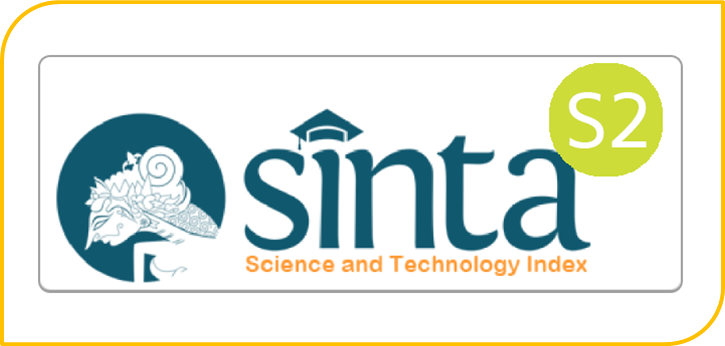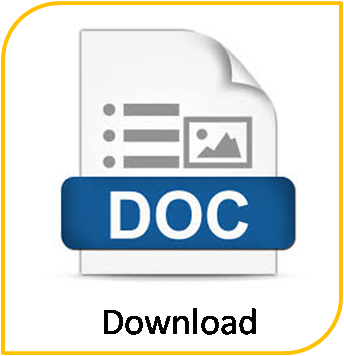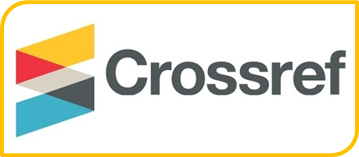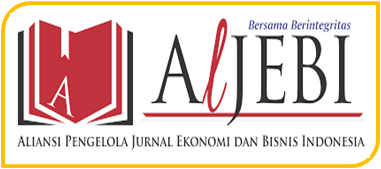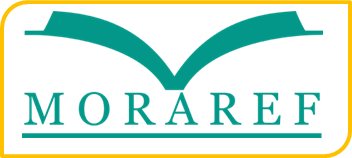SHARIA MICROFINANCE MODELS: A GRAMEEN BANK APPROACH FOR SUSTAINABLE CONSTRUCTION AND WELFARE ENHANCEMENT
Abstract
Keywords
Full Text:
PDFReferences
Abdullah, M. F., Amin, M. R., & Ab Rahman, A. (2017). Is there any difference between islamic and conventional microfinance? Evidence from Bangladesh. International Journal of Business and Society, 18(S1), 97–112. https://www.ijbs.unimas.my/images/repository/pdf/Vol18-S1-paper6.pdf
Ahmed, H. (2002). Financing Microenterprises : An Analytical Study of Islamic Microfinance Institutions. Islamic Economic Studies, 9(2), 27–64. http://www.isdb.org/irj/go/km/docs/documents/IDBDevelopments/Internet/English/IRTI/CM/downloads/IES_Articles/Vol 9-2.
Ahriani, A. (2020). The Multiple Roles of Women in Poor Household in Urban Communities. Journal of Advanced Research in Dynamical and Control Systems, 12(7), 134–138. https://doi.org/10.5373/JARDCS/V12I7/20201993
Aini, B. N. (2019). Pemberdayaan Ekonomi Masyarakat Miskin dengan Pola Grameen Bank (Studi Kasus di Koperasi Syariah as-Sakinah Nganjuk).
Akinyode, B. F. (2016). The Use of Structural Equation Modeling (SEM) in Built Environment Disciplines. International Institute for Science, Technology and Education (IISTE), 6(6), 2225–0484. www.iiste.org
Alhifni, A., & Huda, N. (2015). Kinerja LKMS Dalam Mendukung Kegiatan Ekonomi Rakyat Berbasis Pesantren (Studi Pondok Pesantren Darut Tauhid dan BMT Darut Tauhid). JAM: Jurnal Aplikasi Manajemen, 13(4), 597–609. https://jurnaljam.ub.ac.id/index.php/jam/article/view/810
Amalia, E. (2016). Keuangan Mikro Syariah. Bekasi: Gramata Publishing.
Ampah, S. N., Ambrose, J. O., & Omagwa, J. O. (2017). Effect of access to credit and financial services on poverty reduction in central region of Ghana. International Journal of Business and Social Science, 8(8), 49–60. https://ijbssnet.com/journals/Vol_8_No_8_August_2017/6.pdf
Arifa, L. N. (2021). Banker To the Poor and Its Urgency Based on Indonesian Context (Perceiving the Toughts and Experiences of Muhammad Yunus). Risâlah, Jurnal Pendidikan Dan Studi Islam, 7(2), 226–238. https://doi.org/10.31943/jurnal_risalah.v7i2.188
Aruna, G., & Naidu, M. C. (2014). Impact of Shg Participation on Decision Making Among the Members. Indian Journal of Applied Research, 4(2), 19–20. https://doi.org/10.15373/2249555x/feb2014/38
Ashrafi, D. M., Sarker, M. A. R., Binti Hashim, J., Haque, A., & Nayan, F. K. (2020). An exploration of the youths perception toward social entrepreneurship development: Evidence from Bangladesh. JEMA: Jurnal Ilmiah Bidang Akuntansi Dan Manajemen, 17(1), 88. https://doi.org/10.31106/jema.v17i1.5539
Asian Development Bank. (2016). Impact of Restrictions on Interest Rates in Microfinance (No. 45; Sustainable Development Working Paper Series Impact, Issue 45). www.adb.org
Barua, U., & Khaled, A. F. M. (2023). The Grameen Bank Microfinance Model in the Global North: Processes, Transfer Intermediaries and Adoption. Journal of Comparative Policy Analysis: Research and Practice, 25(5), 546–563. https://doi.org/10.1080/13876988.2023.2223542
Bayulgen, O. (2008). Muhammad Yunus, Grameen Bank and the Nobel Peace Prize: What Political Science Can Contribute to and Learn From the Study of Microcredit. International Studies Review, 10(3), 525–547. https://doi.org/10.1111/j.1468-2486.2008.00803.x
Berber, N., Slavić, A., & Aleksić, M. (2020). Relationship between Perceived Teamwork Effectiveness and Team Performance in Banking Sector of Serbia. Sustainability, 12(20), 8753. https://doi.org/10.3390/su12208753
Coordinating Ministry of PMK. (2019). Strategi Pengentasan Kemiskinan Melalui Sinergi Program Pemberdayaan Masyarakat.
Dhaoui, I. (2015). The role of Islamic Microfinance in Poverty Alleviation : Lessons from Bangladesh Experience. Munich Personal RePEc Archive, 87358(1). https://mpra.ub.uni-muenchen.de/87358/
Divisi Keuangan Mikro Syariah. (2019). Strategi Pengembangan Keuangan Mikro Syariah di Indonesia. Komite Nasional Keuangan Syariah.
Faza, A. R. D. (2022). Social Business Contribution of Grameen Bank Muhammad Yunus in The Development of Poverty Reduction Discourse in Indonesia. International Economic and Finance Review, 1(1), 54–84. https://doi.org/10.56897/iefr.v1i1.5
Fedele, A., & Knibbe, K. (Eds.). (2013). Gender and Power in Contemporary Spirituality. Routledge. https://doi.org/10.4324/9780203074657
Fornell, C., & Larcker, D. F. (1981). Structural Equation Models with Unobservable Variables and Measurement Error: Algebra and Statistics. Journal of Marketing Research, 18(3), 382. https://doi.org/10.2307/3150980
Fuddin, M. K. (2018). Implementation of Grameen Bank Patterns in Increasing and Strengthening the Middle Economic Sector Post-Eruption of Kelud Mountain. Jurnal Ekonomi Pembangunan, 16(1), 35. https://doi.org/10.22219/jep.v16i1.8183
Gamil, Y., & Abd Rahman, I. (2023). Studying the relationship between causes and effects of poor communication in construction projects using PLS-SEM approach. Journal of Facilities Management, 21(1), 102–148. https://doi.org/10.1108/JFM-04-2021-0039
Griessmair, M., & Hippmann, P. (2022). Anger, guilt, and repeated cooperation in social dilemmas. Emotion, 22(3), 444–465. https://doi.org/10.1037/emo0000897
Guo, L. (2018). Trust Mechanisms, Cultural Difference and Poverty Alleviation. CLCWeb: Comparative Literature and Culture, 20(2). https://doi.org/10.7771/1481-4374.3229
Hackett, R. D., & Wang, G. (2012). Virtues and leadership. Management Decision, 50(5), 868–899. https://doi.org/10.1108/00251741211227564
Hair, J. F., Howard, M. C., & Nitzl, C. (2020). Assessing measurement model quality in PLS-SEM using confirmatory composite analysis. Journal of Business Research, 109(August 2019), 101–110. https://doi.org/10.1016/j.jbusres.2019.11.069
Hair, J. F., Hult, G. T. M., Ringle, C. M., Sarstedt, M., Danks, N. P., & Ray, S. (2021). Partial Least Squares Structural Equation Modeling (PLS-SEM) Using R. Springer International Publishing. https://doi.org/10.1007/978-3-030-80519-7
Hamzah, A. (2007). Perbandingan Karakteristik Dasar Antara Grameen Bank Dan Bank Syariah Dalam Mengurangi Kemiskinan Dan Meningkatkan Pertumbuhan Ekonomi. Jurnal Infestasi, 3(1), 1–9. https://doi.org/10.21107/infestasi.v3i1.1177.g999
Handayani, S., Mariatul Qibtiyah, H. A. R., & Amaliyah. (2020). Implementation of sharia-based bank Grameen program through empowerment of women batik communities. International Journal of Innovation, Creativity and Change, 12(12), 405–418. https://www.ijicc.net/images/vol12/iss12/121237_Handayani_2020_E_R.pdf
Handayani, & Sugiarti. (2008). Konsep dan Teknik Penelitian Gender (1st ed.). UMM Press.
Hasan, N., Shetu, H., Chakraborty, B., & Khan, A. G. (2019). Impact of Microcredit Programs on Women Empowerment in Bangladesh: A Comparative Study of Grameen Bank and BRAC. Global Journal of Management and Business Resear. 19(10). https://globaljournals.org/GJMBR_Volume19/6-Impact-of-Microcredit-Programs-on-Women.pdf
Hassan, M. K. (2002). The Microfinance Revolution and the Grameen Bank Experience in Bangladesh. Financial Markets, Institutions & Instruments, 11(3), 205–265. https://doi.org/10.1111/1468-0416.00051
Hidayat, S., Lubis, A. R., & Majid, M. (2019). Pengaruh Gaya Kepemimpinan, Kerjasama Tim Dan Kompensasi Terhadap Kinerja Karyawan Melalui Kepuasan Kerja Pada Pt. Dunia Barusa Banda Aceh. Jurnal Perspektif Ekonomi Darussalam, 5(1), 84–98. https://doi.org/10.24815/jped.v5i1.14088
Inayatul Faizah, S., & Ahmad Husaeni, U. (2019). Economic Empowerment for Poor Women Using Grameen Bank Model in Indonesia. KnE Social Sciences, 3(13), 880. https://doi.org/10.18502/kss.v3i13.4255
Indah, C., & Hakim, A. (2023). Optimization of Social Systems in the Diffusion of Innovations in Traditional Islamic Society. Tribakti: Jurnal Pemikiran Keislaman, 34(1), 13–32. https://doi.org/10.33367/tribakti.v34i1.3114
Ioannidou, E., D’Souza, R. N., & MacDougall, M. J. (2014). Gender Equity in Dental Academics. Journal of Dental Research, 93(1), 5–7. https://doi.org/10.1177/0022034513510178
Iqbal, M., & Llewellyn, D. T. (Eds.). (2002). Islamic Banking and Finance. Edward Elgar Publishing. https://doi.org/10.4337/9781843765318
Ismail, V. Y., Zain, E., & Zulihar. (2015). The Optimization of Human Resource’s Performance in Islamic Microfinance Institutions Through Job Analysis and Competency Model. The Asian Journal of Technology Management (AJTM), 8(1), 56–67. https://doi.org/10.12695/ajtm.2015.8.1.6
Kabeer, N. (2012). Empowerment, Citizenship and Gender Justice: A Contribution to Locally Grounded Theories of Change in Women’s Lives. Ethics and Social Welfare, 6(3), 216–232. https://doi.org/10.1080/17496535.2012.704055
Kartika, D. I. (2019). Women Empowerment Through Micro Credit Using Grameen Bank System. International Journal of Kybernology, 3(1), 56–68. https://doi.org/10.33701/ijok.v3i1.583
KemenPPPA. (2016). Kajian Kebijakan Kepemimpinan Perempuan Dalam Menggerakan Industri Rumahan di Provinsi D.I. Yogyakarta. 14.
KemenPPPA. (2021). Peraturan Menteri Pemberdayaan Perempuan Dan Perlindungan Anak Republik Indonesia Nomor 13 Tahun 2021 Tentang Partisipasi Masyarakat Dalam Pemberdayaan Perempuan Dan Perlindungan Anak. Paper Knowledge . Toward a Media History of Documents, 3(2), 6.
Khandker, S. R. (1996). Grameen Bank: Impact, Costs, and Program Sustainability. Asian Development Review, 14(01), 97–130. https://doi.org/10.1142/S0116110596000048
Khasanah, U., & Wicaksono, A. T. S. (2021). Intermediary performance of Islamic banks in the disruption era: Does it contribute to economic growth? Banks and Bank Systems, 16(1), 103–115. https://doi.org/10.21511/bbs.16(1).2021.10
Krapfl, J. E., & Kruja, B. (2015). Leadership and Culture. Journal of Organizational Behavior Management, 35(1–2), 28–43. https://doi.org/10.1080/01608061.2015.1031431
Kumudini, M. (2015). Microfinance: A Tool for Poverty Alleviation, A Case Study of Rastriya Seva Samithi, Andhra Pradesh, India. International Journal of Innovative Research & Development, 4(10), 244–248. https://www.ijsr.net/archive/v4i1/SUB15689.pdf
Madgwick, P. G., & Wolf, J. B. (2020). Evolution of strategic cooperation. Evolution Letters, 4(2), 164–175. https://doi.org/10.1002/evl3.164
Marwanti, S. R. I., & Astuti, I. D. W. I. (2012). Model Pemberdayaan Perempuan Miskin Melalui Pengembangan Kewirausahaan Keluarga Menuju Ekonomi Kreatif Di Kabupaten Karanganyar Sri, 9(1), 134–144. https://doi.org/10.20961/sepa.v9i1.48814
Matsui, N., & Tsuboi, H. (2015). Microcredit, Inclusive Finance and Solidarity. Solidarity Economy and Social Business, 13–25. https://doi.org/10.1007/978-4-431-55471-4_2
Mohapatra, A. (2014). Women empowerment in India: an Overview. Indian Journal of Applied Research, 4(6). https://doi.org/10.36106/ijar
Morshed, A. (2014). Building Empowerment: Female Grameen Entrepreneurs in Rural Bangladesh. South Asia: Journal of South Asian Studies, 37(4), 605–624. https://doi.org/10.1080/00856401.2014.950405
Mubarok, A. F. (2017). Tinjauan Hukum Islam Terhadap Program Pengentasan Kemiskinan Oleh Grameen Bank. ISTI’DAL; Jurnal Studi Hukum Islam, 4(2), 105–119. https://ejournal.unisnu.ac.id/JSHI/article/viewFile/775/1040
Mughni, A., & Afriadi, F. (2008). Dekomposisi Permasalahan dan Solusi Kebijakan Pengembangan LKMS Berbasis Grameen. Jurnal Akuntansi Berkelanjutan Indonesia, 2(1), 077. https://doi.org/10.32493/jabi.v2i1.y2019.p077-092
Nawawi, Z. M., Soemitra, A., & Dalimunthe, M. (2022). Women’s Economic Empowerment Through Sharia Micro-Finance Institutions In Indonesia: A Qualitative Research. IQTISHADIA, 15(2), 255. https://doi.org/10.21043/iqtishadia.v15i2.15902
Neck, C. P., & Milliman, J. F. (1994). Thought Self-leadership: Finding Spiritual Fulfilment in Organizational Life. Journal of Managerial Psychology, 9(6), 9–16. https://doi.org/10.1108/02683949410070151
Niaz, M. U., & Iqbal, M. (2019). Effect of Microfinance on Women Empowerment : A Case Study of Pakistan. Paradigms, 13(1), 53–60. https://doi.org/10.24312/1900006130109
Njoh, A. J., & Akiwumi, F. A. (2012). The Impact of Religion on Women Empowerment as a Millennium Development Goal in Africa. Social Indicators Research, 107(1), 1–18. https://doi.org/10.1007/s11205-011-9827-4
Osmani, L. N. K. (1998). The Grameen Bank Experiment: Empowerment of Women through Credit. In Women and Empowerment (pp. 67–85). Palgrave Macmillan UK. https://doi.org/10.1007/978-1-349-26265-6_5
Ozorak, E. W. (1996). The Power, but Not the Glory: How Women Empower Themselves Through Religion. Journal for the Scientific Study of Religion, 35(1), 17. https://doi.org/10.2307/1386392
Purnomo, S. D. (2018). Determinants of Income of Poor Women-Headed Households in Madiun City. Eko-Regional Jurnal Pengembangan Ekonomi Wilayah, 13(2), 19–31. https://doi.org/10.20884/1.erjpe.2018.13.2.1152
Rahman, A. (2019). Women and Microcredit in Rural Bangladesh. Routledge. https://doi.org/10.4324/9780429503023
Rahman, R., & Nie, Q. (2011). The Synthesis of Grameen Bank Microfinance Approaches in Bangladesh. International Journal of Economics and Finance, 3(6), 207–218. https://doi.org/10.5539/ijef.v3n6p207
Rahmitha, Hastuti, Widyaningsih, D., Kusumawardhani, N., Prasetyo, D. D., Arfyanto, H., Indrio, V. T., Rakhmad, M. F., & Warda, N. (2016). Poor Women ’ s Livelihoods and Access to Public Services. In SMERU Research Report. https://www.smeru.or.id/sites/default/files/publication/mampu_eng.pdf
Rambu Atahau, A. D., Huruta, A. D., & Lee, C.-W. (2020). Rural microfinance sustainability: Does local wisdom driven - governance work? Journal of Cleaner Production, 267, 122153. https://doi.org/10.1016/j.jclepro.2020.122153
Ranabahu, N., & Wickramasinghe, A. (2022). Sustainable Leadership in Microfinance: A Pathway for Sustainable Initiatives in Micro and Small Businesses? Sustainability, 14(9), 5167. https://doi.org/10.3390/su14095167
Reissmann, M., Storms, A., & Woopen, C. (2021). Individual values and spirituality and their meaning for affective well-being and engagement with life in very old age. Zeitschrift Für Gerontologie Und Geriatrie, 54(S2), 85–92. https://doi.org/10.1007/s00391-021-01974-9
Rouf, K. A. (2012). Grameen Bank women borrowers’ familial and community relationships development in patriarchal Bangladesh. International Journal of Research Studies in Psychology, 1(1), 17–26. https://doi.org/10.5861/ijrsp.2012.v1i1.11
Rouf, K. A. (2015a). Micro Financing Implementation and Expansion Strategies of Grameen Bank in Bangladesh. Global Journal of Management and Business, 15(10), 1–6. https://globaljournals.org/GJMBR_Volume15/1-Micro-Financing-Implementation.pdf
Rouf, K. A. (2015b). Grameen Bank services to Women in Development (WID), Gender and Development (GAD), Women in Business (WIB), Women and Development (WAD) and Women in Environment (WED) approach in Bangladesh. International Journal of Research Studies in Management, 5(2), 97–106. https://doi.org/10.5861/ijrsm.2015.1354
Sajogyo, & Pudjiwati. (2007). Sosiologi Pedesaan. Gadjah Mada University Press.
Saputra, N. (2021). Spiritual Leadership: Tetap Terkendali Menghadapi Perubahan Terburuk Sekalipun. 339–363. Manajemen dan Kepemimpinan Kontemporer. Scopindo Media Pustaka.
Saputri, A. A. I. (2018). Implementation of Financing Compass for Welfare Partner Operational System Grameen Bank in Banyumas Regency. Ijtimā Iyya Journal of Muslim Society Research, 3(1), 21–36. https://doi.org/10.24090/ijtimaiyya.v3i1.1674
Sarker, A. E. (2001). The Secrets of success: the Grameen Bank experience in Bangladesh. Journal Labour and Management in Development, 2(1), 1–17.
Schuberth, F. (2021). Confirmatory composite analysis using partial least squares: setting the record straight. Review of Managerial Science, 15(5), 1311–1345. https://doi.org/10.1007/s11846-020-00405-0
Schuberth, F., Rademaker, M. E., & Henseler, J. (2023). Assessing the overall fit of composite models estimated by partial least squares path modeling. European Journal of Marketing, 57(6), 1678–1702. https://doi.org/10.1108/EJM-08-2020-0586
Sen, G. (2019), Gender Equality and Women's Empowerment: Feminist Mobilization for the SDGs. Global Policy, 10: 28-38. https://doi.org/10.1111/1758-5899.12593
Sengupta, R., & Aubuchon, C. P. (2008). The Microfinance Revolution: An Overview. Federal Reserve Bank of St. Louis Review, 90(1), 9–30. https://doi.org/10.20955/r.90.9-30
Shahi, M. (2015). Emerging Face of Micro-Finance in India. International Journal Of Business Management, 2(1), 653–661. https://euroasiapub.org/wp-content/uploads/2016/09/5FMJune-2238-1.pdf
Shukran, K., & Rahman, F. (2011). A Grameen Bank Concept: Micro-credit and Poverty Alleviation Program in Bangladesh. International Conference on Emerging Trends in Computer and Image Processing, 47–51.
Singh, R. K., & Hira, R. (2017). Exploring notion of Spirituality using Grounded Theory: Young adult’s perspective. DECISION, 44(3), 171–178. https://doi.org/10.1007/s40622-017-0151-y
Soedarso, E. H. (2013). Penilaian Kinerja Fisik (Materi) Koperasi Syari’Ah Menurut Perspektif Shari’Ate Enterprise Theory Dengan Nilai Tambah Syari’Ah Dan Zakat Sebagai Indikator. Jurnal Riset Akuntansi Dan Keuangan, 1(3), 194. https://doi.org/10.17509/jrak.v1i3.6701
Sultana, H. Y., Jamal, M. A., & Najaf, D. E. (2017). Impact Of Microfinance on Women Empowerment Through Poverty Alleviation, An Assessment of Socioeconomic Conditions in Chennai City of Tamil Nadu. Asian Journal For Poverty Studies, 3(1), 175–183. https://doi.org/10.33369/ajps.v3i2.2785
Sundar, I. (2017). Gender Equality and Women Empowerment. International Journal of Humanities and Social Sciences, 7(1), 7–21. https://mail.ripublication.com/ijhss17/ijhssv7n1_02.pdf
Sutiyo, Pitono, A., Raharjanto, T., & Sinaga, J. B. B. (2020). Woman Microfinance in Indonesia: Present Status and Future Direction. International Journal of Rural Management, 16(1), 105–124. https://doi.org/10.1177/0973005219898922
Swain, R. B. (2006). Microfinance and Women’s Empowerment: Evidence from the Self Help Group Bank Linkage Programme in India. Sweden: Uppsala University.
Takahashi, K., Higashikata, T., & Tsukada, K. (2010). The short-term poverty impact of small-scale, collateral-free microcredit in indonesia: A matching estimator approach. Developing Economies, 48(1), 128–155. https://doi.org/10.1111/j.1746-1049.2010.00101.x
Tatiana, N., Igor, K., & Liliya, S. (2015). Principles and Instruments of Islamic Financial Institutions. Procedia Economics and Finance, 24(July), 479–484. https://doi.org/10.1016/S2212-5671(15)00613-9
Tentama, F., & Nabilah, B. R. (2020). Construct validity of employability: Confirmatory factor analysis of the employability scale. International Journal of Scientific and Technology Research, 9(2), 538–542. https://eprints.uad.ac.id/20082/
Tomarken, A. J., & Waller, N. G. (2005). Structural equation modeling: Strengths, limitations, and misconceptions. Annual Review of Clinical Psychology, 1, 31–65. https://doi.org/10.1146/annurev.clinpsy.1.102803.144239
Tri Sakti, H., & Sugiarti. (2002). Konsep dan Teknik Penelitian Gender. UMM Press.
Uddin, M. A. (2014). Exploring the Leadership Style of Dr. Muhammad Yunus at Grameen Bank of Bangladesh. Skyline Business Journal, 10(1), 43–48. https://www.skylineuniversity.ac.ae/sbj/volume10/exploring-the-leadership-style-of-dr-muhammad-yunus-at-grameen-bank-of-bangladesh
Wahid, A. (1999). The Grameen Bank and Women in Bangladesh. Challenge, 42(5), 94–101. https://doi.org/10.1080/05775132.1999.11472124
Wahid, A., & Hsu, M. (2000). The Grameen bank of Bangladesh: History procedures, effects and challenges. Asian Affairs, 31(2), 160–169. https://doi.org/10.1080/0002889708506224
World Bank. (2012). Gender Equality and Development.
Yaron, J. (1994). Successful Rural Finance Institutions. Finance & Development, 31(1), 32–35. https://doi.org/10.5089/9781451953107.022
Yasin, M. Z. (2020). The Role of Microfinance in Poverty Alleviations: Case Study Indonesia. Airlangga International Journal of Islamic Economics and Finance, 3(2), 76. https://doi.org/10.20473/aijief.v3i2.23879
Yunus, M. (2004). Grameen Bank, Microcredit and Millennium Development Goals. Economic and Political Weekly, 39, 4–10. https://doi.org/10.2307/4415509
Zuhri, A., Laily Wulandari, N., Purnomo, A., & Budiyono, F. (2019). The Role of Women in Improving Household Economy. International Joint Conference on Science and Technology. Chapter ICSS (International Conference on Social Science), 149–153. https://journal.trunojoyo.ac.id/ijcst/article/view/8222
Zunaidi, A., & Maghfiroh, F. L. (2021). The Role Of Women In Improving The Family Economy. Dinar : Jurnal Ekonomi Dan Keuangan Islam, 8(1), 61–79. https://doi.org/10.21107/dinar.v8i1.10581
DOI: https://doi.org/10.18860/ed.v12i1.23722
Refbacks
- There are currently no refbacks.
Editorial Office:
Megawati Soekarnoputri Building
Faculty of Economics
E-mail: eldinar@uin-malang.ac.id
Universitas Islam Negeri Maulana Malik Ibrahim Malang
E-ISSN 2622-0083

El Dinar under a CC BY SA 4.0 International License.
Member of:
Indexed By:

